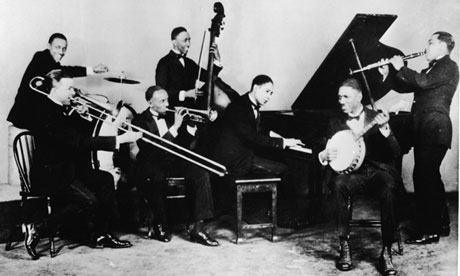By Laurie Dujardin
JAZZ: a genre of music that originated during the late 19th and early 20th century. It emerged in many parts of the United States of independent popular music styles, linked by the common bond of African American and European American musical parentage. Jazz spans a range of music from Ragtime to the present day, a period of over 100 years and has proved to be very difficult to define. Jazz makes heavy use of improvisation, polyrhythms, syncopation, and the swung note, as well as aspects of European harmony, American popular music, the brass band tradition, and African musical elements such as blue notes and ragtime. The birth of jazz in the multicultural society of America has led intellectuals from around the world to hail jazz as one of America's original art forms. As jazz spread around the world it drew on different national and regional cultures, giving rise to many distinctive styles. (Wikipedia)
Jelly Roll Morton, a creole, claimed to have invented jazz in 1902 in New Orleans, and there's plenty of evidence to support his claims. Prior to this, ragtime piano music accompanied silent films. The first jazz recordings came out of New Orleans, via New York, in 1917, and the new style quickly swept North America and Europe. It was adopted as the music of choice by "rebellious youth" and the JAZZ AGE was born.
Then came a massive migration of blacks and their music northward to industrial cities including Montreal, seeking work. Next came the U.S. prohibition of alcohol sales and consumption (1920-1933). I neglected to mention something many people don't know, that there was previously (1900-1916) a prohibition in Canada that was voted in province-by-province, EXCEPT in Quebec where it was resoundingly rejected.
So you can see the different elements coming together to make Montreal a major party town. There's also the proximity to the metropolis of New York linked by major railway lines and the Saint Lawrence Seaway. Americans (and Canadians) started coming by the droves as word spread about the love of partying and entertainments late into the night. Night clubs, dancehalls, burlesque cabarets and vaudeville theatres multiplied at a furious pace. Of course, that was closely followed by organized crime, with its gambling, prostitution, extortion and loansharking, etc. But all of these places employed jazz musicians and they just couldn't get enough of them. Black musicians were also attracted to Montreal because it didn't have the brutal segregation laws that existed in the U.S.
How Montreal became a great jazz town
From the 1920s through the 1940s, Montreal was gaining an international reputation for its booming nightlife and all the jazz greats came through at one time or another, and there were now hundreds of clubs.
Another aspect of Montreal's claim to musical fame is that it was actually the birthplace of the Canadian recording industry and the only city in Canada where musicians could record until after the Second World War. The first recording studio was opened by the man who invented the gramophone, Emile Berliner, a German who emigrated from New York in 1897. By this means, music was gaining a large listening audience.
The fun and frivolity in Montreal was hardly even dampened by the Second World War (1939-1945). Essentially, Montrealers ignored it and carried on as usual, now welcoming the Big Band Era and Swing. Social dancing was all the rage now.
After the War, in 1945, a new form of jazz was born, called Bebop, which started with young black New York musicians. Innovative and complex, it featured richer harmonies and unconventional phrasings and rhythms. Artistry and virtuosity mattered, and there was an attitude that went along with it, in language, dress and behaviour, called "cool". This was not music to dance to. People became spectators, listeners, and it took them quite a while to get used to it. This more sophisticated music, a kind of conversation between highly trained musicians, left many of the former jazz musicians behind.
However, in the southern United States something called Rockabilly ( a combination of country music and black dancehall music) was beginning to percolate and it burst out into Rock n roll at about the same time as the advent of television. Jazz went quiet and many, many clubs closed in the 1950s .But it wasn't long before jazz reappeared in new forms known as Rhythm and Blues, which was really made popular first in Great Britain before being returned to North America, where it had quietly originated. And so new forms of "musical rebellion" were born.
However, jazz today still has a hold in Montreal. For 34 years it has been home to the world's largest jazz festival and this city continues to produce a large cadre of accomplished musicians of all types, possibly due to the number of CEGEPS and universities offering excellent music programs. Even the old styles of jazz survive here in some form (witness the Swing revival), as there are always people looking for something different from the mainstream.
Vic Vogel Big Band at Montreal Jazz Fest
So that's the story of Jazztown Montreal, and long may she swing!
Source: John Gilmore. 1988. Swinging in Paradise: The Story of Jazz Montreal. Montreal: Vehicle Press.

Leave a comment